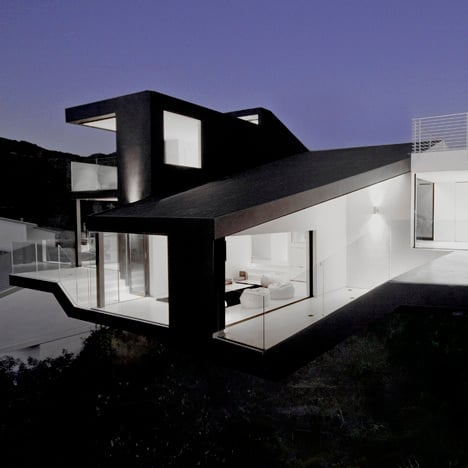The rooms of a black and white house in California lead out to a series of stepped terraces with a view of the famous Hollywood sign.
The single-storey house, named Nakahouse, was designed by American studio XTEN Architecture and sits upon the foundations of a 1960s house that has been demolished.
A living room and kitchen-diner wrap around the largest of the terraces, from which a steel staircase leads up to a deck on the roof.
Elsewhere, sliding glass panels disappear into the walls to open bedrooms out to smaller terraces.
XTEN Architecture also designed a gallery perched on top of an art collector’s house in Los Angeles - see our earlier story here.
Other monochrome projects on Dezeen include an apartment in Paris filled with blocks and a Singapore hotel where white statues have their heads in the clouds.
Photography is by Steve King.
Here is some text from the architects:
Nakahouse, Hollywood Hills, California
Nakahouse is an abstract remodel of a 1960's hillside home located on a West facing ridge in the Hollywood Hills, just below the Hollywood sign.
To the South and West are views of the Beechwood Canyon; to the East is a protected natural ravine, with a view of Griffith Park Observatory in the distance.
The existing home was built as a series of interconnected terraced spaces on the downslope property.
Due to geotechnical, zoning and budget constraints the foundations and building footprint were maintained in the current design.
The interior was completely reconfigured however, and the exterior was opened up to the hillside views and the natural beauty of the surroundings.
A large terrace was added to link the kitchen/ dining area with the living room, with a steel stair leading to a rooftop sundeck.
Terraces were also added to the bedroom wing and the upper master bedroom suite to extend the interior spaces through floor to ceiling glass sliding panels that disappear into adjacent walls when open.
The exterior walls are finished in a smooth black Meoded ventetian plaster system, designed to render the building as a singular sculptural object set within the lush natural setting.
A series of abstract indoor-outdoor spaces with framed views to nature are rendered in white surfaces of various materials and finishes; lacquered cabinetry, epoxy resin floors and decks and painted metal.
The contrast between the interior and exterior of the house is intentional and total.
While the exterior is perceived as a specific finite and irregular object in the landscape the opposite occurs inside the building.
Once inside the multitude of white surfaces blend the rooms together, extending ones sense of space and creating a heightened, abstract atmosphere from which to experience the varied forms of the hillside landscape.

